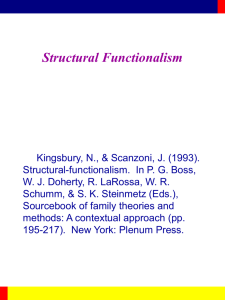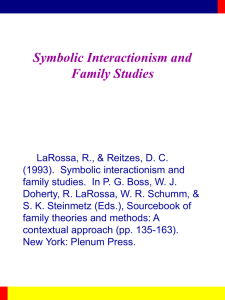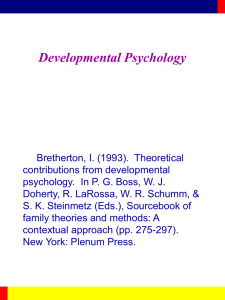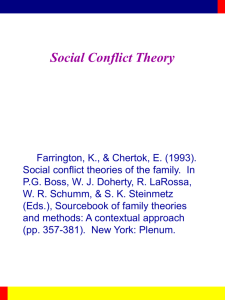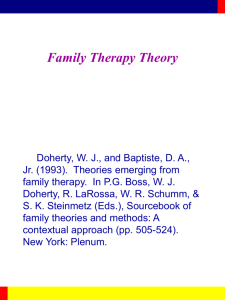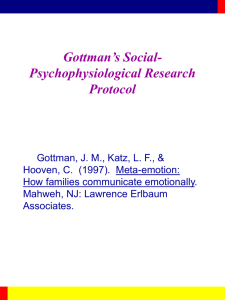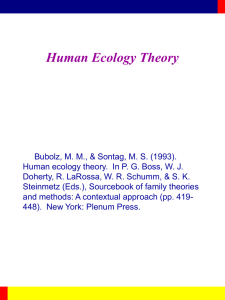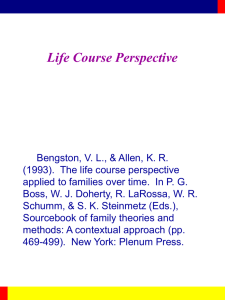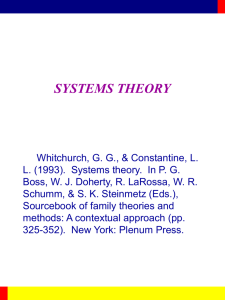Exchange & Resource Theories
advertisement
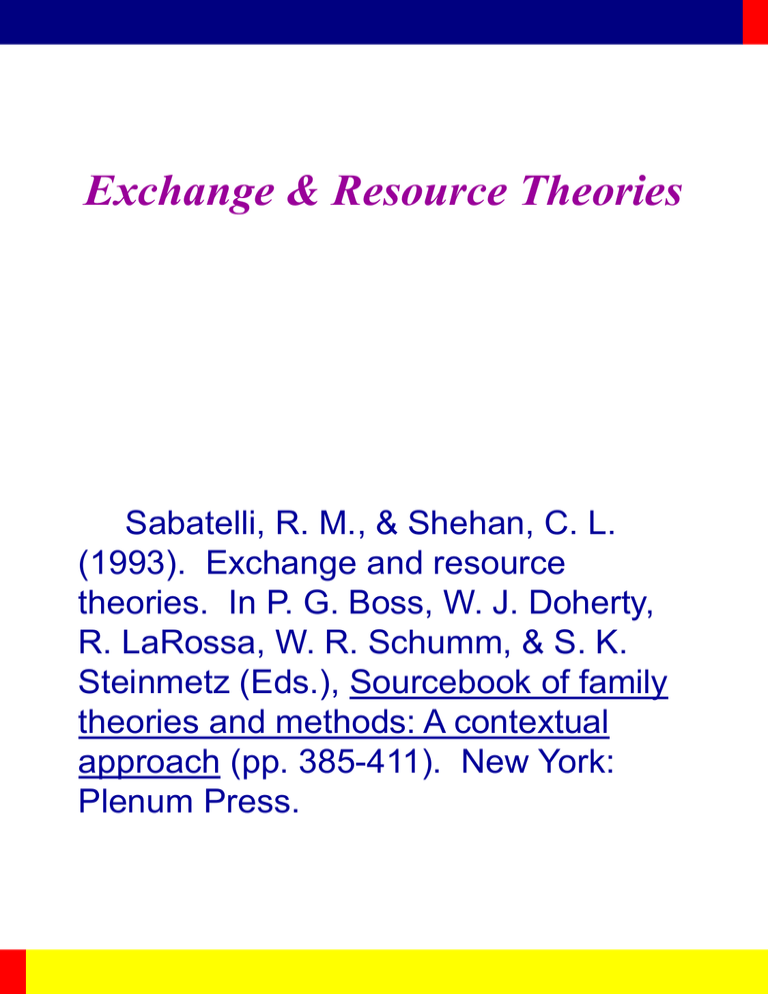
Exchange & Resource Theories Sabatelli, R. M., & Shehan, C. L. (1993). Exchange and resource theories. In P. G. Boss, W. J. Doherty, R. LaRossa, W. R. Schumm, & S. K. Steinmetz (Eds.), Sourcebook of family theories and methods: A contextual approach (pp. 385-411). New York: Plenum Press. Metatheoretical Issue: Collectivism Versus Individualism Collectivism (a/k/a structuralism): the social system influences the behavior of individuals in interaction. This emphasizes the influence of social norms on individual behavior. Individualism: social structures develop based on behaviors of individuals to meet their own needs. Dr. Ronald J. Werner-Wilson Core Assumptions Humans seek rewards and avoid punishment. Based on their expectations, humans seek to maximize rewards and minimize costs. Humans calculate rewards, costs, and consider alternatives before they act. The standards that are used to evaluate rewards and costs vary between individuals and may change over time. The importance attached to the behavior of others in relationships vary between individuals and may change over time. If a reward exceeds it’s anticipated value, it’s future value will diminish. Dr. Ronald J. Werner-Wilson Assumptions About the Nature of Relationships: Social exchanges are interdependent: the ability to obtain profits is based on the ability to reciprocate by providing rewards. Experience in relationship influences subsequent exchanges. Social exchanges are regulated by norms of reciprocity. Social exchanges are regulated by norms of fairness. Levels of attraction and dependence influence relationship dynamics, stability of relationships over time. Dr. Ronald J. Werner-Wilson Limitations Not all social behavior is based on rational decision-making, a critique that has also been directed toward behaviorism. Tautology: it is difficult to make an operational distinction between what people value, what people perceive as rewarding, and how they behave. Radical-feminist critique: Underlying assumptions value separation of people rather than connection. This is problematic for explaining the behavior which values connectedness. Exchange theory fails to explain or at least undervalues altruistic behavior. Dr. Ronald J. Werner-Wilson Major Contemporary Concepts Overview of Concepts: Concepts are defined and interrelationships are outlined and modeled graphically. Concepts are classified into four general categories: Individual characteristics (e.g., resources, expectations, perception of alternatives). Norms and rules that regulate relationships (e.g., norms of reciprocity and equity). Characteristics of the exchange which emerge as a result of interactional experiences that influence the decision to remain or depart. Relationship dynamics (e.g., decision making, power, control). Dr. Ronald J. Werner-Wilson Rewards, Costs, and Resources Rewards: sources of positive reinforcement including pleasures, satisfactions, gratifications. They occur on a continuum from concrete to symbolic. Blau (1964) suggested six types of social rewards: personal attraction, social acceptance, social approval, instrumental services, respect/prestige, compliance/power. Dr. Ronald J. Werner-Wilson Rewards, Costs, and Resources (cont.) Costs: punishments or lost rewards. Blau suggested three types: Investment: time and effort devoted to developing skills which will be used to reward others. Direct costs: resource given to another in exchange for something else. Opportunity: loss of rewards which would have been available elsewhere. Resources: anything that can be transmitted through interpersonal behavior, including commodities, material, or symbolic matter. Dr. Ronald J. Werner-Wilson Satisfaction with Exchange Relationships See Figure 16-1 for graphic representation of factors mediating relationship satisfaction. Comparison level (CL): a personal subjective standard used to evaluate a relationship which is based on previous experience and expectations. Dr. Ronald J. Werner-Wilson Relationship Stability See Figure 16-2 for graphic representation of factors which influence relationship stability. Comparison level for alternatives (Clalt): Construct developed to explain a person’s decision to remain or terminate a relationship. Defined as the lowest level outcome a person will accept from a relationship in light of available alternatives. Determined by the comparison of the current relationship to the perceived best available alternative. It is a subjective assessment. Dr. Ronald J. Werner-Wilson Relationship Stability (cont.) Dependence: degree of perceived reliance on the relationship. Barriers: discourage terminating a relationship by fostering dependence even if attraction is negative. There are two: Internal: feelings of obligation or indebtedness which increase the psychological cost of the relationship. External: group membership, community pressure, legal pressure, and economic concerns which increase the social and/or economic cost of terminating the relationship. Dr. Ronald J. Werner-Wilson Typology of Marital Quality and Stability See Figure. Four possible combinations of marital quality and stability. Assumption: location in a quadrant is dependent on the balance between rewards and costs so relationships may change over time. Family violence: research on women as victims has revealed that those who are more likely to leave are more likely to be employed, view themselves as having personal resources, have shorter duration marriages, less invested in their relationship. Dr. Ronald J. Werner-Wilson Norms Regulating Exchange Relationships See Figure 16-3 which integrate norms with trust and commitment. Normative orientation (e.g., gender roles): internalized and modified by experience. Distributive justice: perceived fairness which is based on ratio of costs/benefits to expectations. Degree of allowable deviation is influenced by social norms. Reciprocity: level of responsiveness between exchanges. Motivation is influenced by feelings of indebtedness. Dr. Ronald J. Werner-Wilson Trust and Commitment See Figure 16-3 which integrates trust and commitment with norms. Trust: belief that partner will not exploit. Norms of reciprocity and fairness influence feelings of trust. Commitment: willingness to participate in a relationship over a long period of time. It builds stability by increasing dependence. Dr. Ronald J. Werner-Wilson Exchange Dynamics See Figure 16-4 Power: ability to control another; this is distinguished from authority, the ability to legitimately extract compliance. Assumption: dependence and power are inversely related. Assumption: resources and power are positively and linearly related. Exchange relationships are characterized by attempts to balance dependence and power. Dr. Ronald J. Werner-Wilson
